In 2020, Selby Gardens adopted Historic Spanish Point as a second campus. This cultural landmark less than 10 miles from the Downtown Sarasota campus boasts an archaeological record that encompasses approximately 5,000 years of Florida prehistory. A onetime pioneer homestead and the former winter estate of Chicago-born Bertha Palmer, Marie Selby Botanical Gardens’ Historic Spanish Point campus provides visitors the opportunity to explore that heritage via an ancient shell midden and collection of historic structures and serves as one of the largest preserves showcasing native Florida plants that is interpreted for and open to the public. It was Palmer’s family who both donated the property and helped it become the first site in Sarasota County to be listed in the National Register of Historic Places.
Selby Gardens is the only botanical garden in the world dedicated to the display and study of epiphytic orchids, bromeliads, gesneriads and ferns, and other tropical plants. Since 1973, scientists from Selby Gardens have ventured into some of the world’s wildest places to identify, study, collect, and learn from these resourceful, remarkable plants. Today Selby Gardens’ two campuses, both established by forward thinking women of their time, offer visitors 45 acres of bayfront sanctuaries for connecting with native nature and learning about both tropical plants and regional history.
Downtown Sarasota Campus
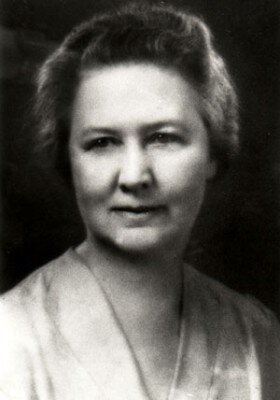 Marie Selby was born Mariah Minshall in Wood County, West Virginia, on August 9, 1885. When Marie was still a young girl, the Minshall family moved to Marietta, Ohio where her father studied geology at Marietta College and invented parts for oil drilling equipment. The Minshall family frequently went on camping and hiking trips along the Ohio River; perhaps it was this early introduction to nature that spawned in Marie her love of the out-of-doors.
Marie Selby was born Mariah Minshall in Wood County, West Virginia, on August 9, 1885. When Marie was still a young girl, the Minshall family moved to Marietta, Ohio where her father studied geology at Marietta College and invented parts for oil drilling equipment. The Minshall family frequently went on camping and hiking trips along the Ohio River; perhaps it was this early introduction to nature that spawned in Marie her love of the out-of-doors.
Marie was an accomplished pianist, and attended a music seminary in Illinois. Shortly after completing her musical studies she met William (Bill) Selby, a partner with his father in the Selby Oil and Gas Company. William and Marie were married on January 31, 1908, in the First Presbyterian Church of Marietta. Early in their marriage the young couple was intrigued by the country’s first cross-country automobile race. They decided to travel the same course, and outfitted their touring car with spare parts and camping equipment. As a result of the Selby’s enthusiasm and determination, Marie Selby became one of the first women to cross the country by car.
Bill Selby had visited Sarasota before his marriage and was drawn into the area by the excellent fishing waters and the astounding beauty of the west coast of Florida. He brought his young wife to Sarasota in hopes that she would share his enthusiasm. She did, and they bought seven acres of land bordering on Sarasota Bay and Hudson Bayou. Little did they dream, at that moment, of the exquisite Sarasota landmark their property would become in the not-so-distant future. In the early 1920s the Selbys built a Spanish-style, 2-story house among the laurel and banyan trees.
Landscaping of the Selby home site was planned by Marie. Borders of flowers bloomed along the roadway which led to the tip of the peninsula. A large rose garden figured prominently in the overall design – a garden Marie was always reluctant to leave behind during summers spent at the Selby ranch in Montana. Despite their enormous wealth (oil and mining industry produce great wealth for William), the Selbys lived a quiet and unpretentious life. Their home was modest as was their entertaining style. They were not a part of the Sarasota social scene. Both Marie and Bill Selby dressed plainly, as their interests lay in outdoor activities. One would often find Marie in a cotton dress and sneakers. They owned a ranch where they raised purebred Angus cattle and rode horses, often seen around town in dusty riding clothes.
Boating was another favorite activity at the Sarasota Yacht Club. In 1928, a reception was held at the Selby home for local members and visiting members of other yacht clubs participating in the annual Regatta. That year, Marie Selby won the “Express Cruiser Race” and the Sarasota Yacht Club won overall, retaining the trophy won in 1927.
Gardening Passion
Yet one guesses that Marie’s love of nature and of gardening was her most consuming passion. She was a charter member of Sarasota’s first garden club, the Founder’s Circle. She had a great desire to keep Sarasota a beautiful and green place and was disturbed later in life by the proliferation of high-rise construction. The row of bamboo on the bay side of the property was planted by Marie to block her view of the offending condominiums.
In 1955, William Selby had established the William and Marie Selby Foundation. The impact of Selby Foundation in the Sarasota community has been, and continues to be, enormous – on education, the arts, youth and children, libraries, health services, and programs in support of the aged. William Selby died on December 4, 1956 and Marie continued to live quietly in the home she loved until her death on June 9, 1971. The contents of Marie Selby’s will revealed her wish to leave her property to the community as a botanical garden “for the enjoyment of the general public.” A board of directors was appointed and after consultation with the New York Botanical Garden and the University of Florida, it was decided that the garden should specialize in epiphytic plants, thereby making it unique among the more than 200 botanical gardens in the country.
Marie Selby Botanical Gardens was officially opened to the public on July 7, 1975. Marie Selby’s final wish was fulfilled, and the Selby legacy was in full bloom. In November 2001, William and Marie Selby were reinterred in front of their beloved home on the grounds of Selby Gardens. A triangular-shaped fountain pays tribute to this pioneering couple whose generosity has touched generations of Sarasotans. A plaque on the Selby House honors Marie as a Great Floridian, so named by the Florida Legislature in 2000 for her significant contributions to the history and culture of the state.
Since the Gardens originally opened to the public, the property has more than doubled in size from seven to nearly 15 acres. The historic Payne Mansion on adjoining property was purchased in 1973 and now houses the Gardens’ Museum. Selby Gardens maintains a plant collection representing specimens collected from New World Tropic locations during research expeditions and acquisitions from international institutions. The collection numbers more than 20,000 greenhouse plants, plus thousands more in the outdoor gardens. Eight greenhouses include the stunning Tropical Conservatory – the only greenhouse that is open to the public where unusual flora can be seen year-round. The Botany Department provides headquarters for the Bromeliad, Gesneriad, and Orchid Research Centers, and Selby Gardens’ Herbarium, Spirit Collection and Molecular Laboratory. The Ann Goldstein Children’s Rainforest Garden, opened in November 2013, features interactive stations that allow children and families to explore rainforest plants and habitats. Marie Selby Botanical Gardens has, in short, become a respected center for research and education, as well as a famous showplace that delights more than 200,000 visitors each year.
Historic Spanish Point Campus
With an archaeological record that encompasses approximately 5,000 years of Florida prehistory, this National Register of Historic Places museum is referred to as one of the largest intact actively preserved archaeological sites of the prehistoric period on the gulf coast of Florida. Habitation of the site (known as the Palmer site 8s02) spans the Late Archaic period [5,900-3,200 years ago] through to the Manasota and Late Woodland periods [3,200-1,000 years ago.]
Prehistoric people living on our bay’s shore saw the introduction of ceramics and the transition from nomadic hunters and gatherers to settled subsistence societies.They capitalized on the abundant resources provided by the gulf, marsh, woodland and bay ecosystems and utilized growing specialized tool technology to further establish the permanent and seasonal settlements.
Archaic period sites are not as prevalent on the gulf coast and are often not as well-preserved as Historic Spanish Point’s Hill Cottage Midden. Archaeological excavations and examinations of data place this midden clearly in the Archaic formative time. Given its age and the potential for further study, Hill Cottage Midden is among the most important sites in Florida and may be one of the oldest and largest ceremonial shell ring middens in the southeastern United States.
A midden is a dump for domestic waste. The word is used by archaeologists worldwide to describe any kind of feature containing waste products relating to day-to-day human life. Middens may be convenient, single-use pits created by nomadic groups or long-term, designated dumps used by sedentary communities that accumulate over several generations. In the latter case, a midden’s stratigraphy can become apparent. Midden deposits can contain a variety of archaeological material, including animal bone, shell, botanical material, potsherds, debitage (the leftover pieces from making stone flake points) and other artifacts associated with past human occupation.
These features provide a useful resource for archaeologists who wish to study the diet and habits of past societies. Middens with damp, anaerobic [low to no oxygen] conditions can even preserve organic remains which can then be analyzed to obtain information regarding climate and seasonal use.
The two large shell middens forming the Late Woodland and Manasota [3,200-1,000 years ago] context of the Palmer Site 8So2 offer a substantial glimpse at those populations, along with the Burial Mound, which is considered one of the largest systematically excavated mortuary sites in the southeastern United States. The excavation in 1959-1962 by Ripley P. Bullen created one of the biggest osteological collections housed at the University of Florida’s Museum of Natural History, allowing for comprehensive study.
People living here 1000-2000 years ago were relatively healthy with an average age of 25-50 years. Bullen excavated over 429 individuals along with 4 dogs and a Florida Alligator. The Alligator was ceremonially interred with grave goods and appears to be the last burial in the mound. Bullen found no other disturbances after or above the level of the full Alligator skeleton.
Though limited, grave goods and ceremonial elements were included with both the human and the animal burials in the mound. Items like pottery, lithics, shell, and faunal material were part of the grave goods and/or burial inclusions. The styles and cultural affiliations of these were common to the regional culture of the time period leading us to propose the people here were not of their own subculture.
Prehistoric people disappear from the archaeological record of the Palmer site 8s02 sometime prior to AD 1100. To date, no evidence of European contact has been found indicating under the current knowledge that the site was abandoned until the Webb family arrived in 1867. Due to the concerted efforts of the Webbs, the Palmers, and Gulf Coast Heritage Association, Inc., this significant archaeological site has been preserved in a relatively pristine state, again making 8So2 one of the key sites in Florida.
The rich heritage of human habitation at Historic Spanish Point entered a new phase in 1867 when John Greene Webb and his family from Utica, New York established a homestead on the shores of Little Sarasota Bay. A Spanish trader the family met in Key West told them of an elevated point of land on the bay. When the Webbs found the special piece of Florida wilderness, it was just right for them and they settled here. The Webbs named their homestead Spanish Point to honor the good advice of the trader. (This is the only historical or archaeological evidence of a Spanish connection to the museum.)
John Webb and his family planted citrus, sugar cane, and many vegetables. The family built a packing house to prepare it for market. To transport the produce, John’s sons Jack and Will, along with son-in-law, Frank Guptill, built a ten-ton schooner called Vision. John Webb’s wife, Eliza, her sister Emily, and their daughters, Anna, Lizzie and Ginnie also worked on the homestead in the early years. Anna and Ginnie liked to sketch their new surroundings, and the museum’s collections include many of these drawings and letters.
The Webbs encouraged winter boarders to come to stay with them. These boarders enjoyed the mild climate, walks along the nearby beaches, fishing in the bay, hunting, sailing and other leisure activities of the day. Thus the first tourist resort in the area was established. Webb’s Winter Resort was a success for the family and one of the dormitories for the guests, built in 1885 by son Jack Webb, is now known as White Cottage. Today it features an exhibition about Mrs. Potter Palmer who also used the building for her guests when she owned the land.
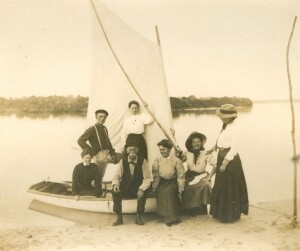 John Webb became a Postmaster in 1881 when he requested a Post Office be placed at Spanish Point so the family wouldn’t have to sail the 15-20 miles to get their mail. The US Postal Service informed him that the place needed to have a one-word name, so John chose “Osprey,” no doubt inspired by the birds were so commonly seen over the bay. It was the only post office with that name in America, and letters would arrive from all over the world simply addressed, “Osprey, USA.”
John Webb became a Postmaster in 1881 when he requested a Post Office be placed at Spanish Point so the family wouldn’t have to sail the 15-20 miles to get their mail. The US Postal Service informed him that the place needed to have a one-word name, so John chose “Osprey,” no doubt inspired by the birds were so commonly seen over the bay. It was the only post office with that name in America, and letters would arrive from all over the world simply addressed, “Osprey, USA.”
In the early 1900s, the Webb family sold parcels of the homestead to new settlers. All members of the original pioneer Webb family are buried in the Pioneer Cemetery next to Mary’s Chapel except for Jack Webb who had moved to California. The original Mary’s Chapel was built at the request of family members of Mary Sherrill who stayed at Webb’s Winter Resort and sadly died at a very young age. The chapel was reconstructed in 1986, with the original stained glass windows and the bronze bell.
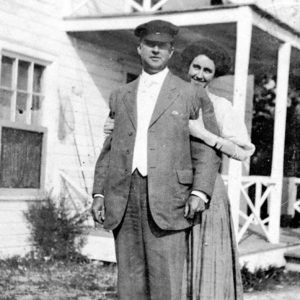 Florida owes its success to people like John Webb and his intrepid family who braved the heat, humidity, insects, illness, fires, and risk of hurricanes to settle and build up the gulf coast region. Historic Spanish Point is proud of this aspect of our story and invites you to experience it first hand by strolling through the 30-acres of nature and gardens, and by engaging yourself in the past by touring the historic buildings.
Florida owes its success to people like John Webb and his intrepid family who braved the heat, humidity, insects, illness, fires, and risk of hurricanes to settle and build up the gulf coast region. Historic Spanish Point is proud of this aspect of our story and invites you to experience it first hand by strolling through the 30-acres of nature and gardens, and by engaging yourself in the past by touring the historic buildings.
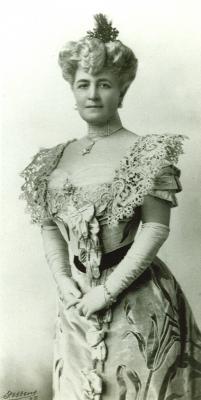 She dined with royalty, socialized with captains of industry, enjoyed close connections to the White House, and had a good head for business. She raised children and enjoyed her grandchildren, buried a beloved husband, and chaired the Board of Lady Managers for Chicago’s World’s Columbian Exposition. Mrs. Potter Palmer also loved Sarasota. She was heard to say that the bay reminded her of the Bay of Naples, Italy.
She dined with royalty, socialized with captains of industry, enjoyed close connections to the White House, and had a good head for business. She raised children and enjoyed her grandchildren, buried a beloved husband, and chaired the Board of Lady Managers for Chicago’s World’s Columbian Exposition. Mrs. Potter Palmer also loved Sarasota. She was heard to say that the bay reminded her of the Bay of Naples, Italy.
In 1910 Bertha Palmer made her first impact on Sarasota history and on the Spanish Point homestead. The Chicago socialite and widow of Potter Palmer came to Sarasota to establish a winter estate. She purchased thousands of acres for cattle ranching, citrus groves, and real estate development. The Webb homestead was part of the land she chose for her 350-acre estate which she named “Osprey Point.” She preserved the pioneer buildings and connected them with lavish formal gardens and lawns.
Many of these garden elements have been restored at Historic Spanish Point. The classical columns of her Pergola & Sunken Garden still glow in the Florida sun with vibrant bougainvillea tightly hugging their bases, an aqueduct meanders through the tropical foliage with its waters flowing over a shell cascade into a reflecting pool, and a tall classic portal serenely stands over a lush green lawn. The Pergola & Sunken Garden is a popular location for wedding ceremonies.
Mrs. Palmer’s varied business interests in Sarasota may have contributed to the land boom and further development of the gulf coast. One of these interests was cattle ranching. As a member of the Florida State Livestock Association, she operated a 15,000-acre ranch she called Meadow Sweet Pastures.
New techniques and innovations in the field of cattle ranching improved production; one of these was the use of large concrete vats where the animals were “dipped” in medicines and insect repellants. Meadowsweet Pastures was acquired by the State of Florida and is now a substantial part of the Myakka River State Park.
Bertha Palmer died of breast cancer at age 68 in May of 1918 while here at her winter estate. The Palmer family maintained Osprey Point and in 1959, her grandson Gordon Palmer sponsored the three-year excavation by Ripley P. Bullen of the archaeological site which now encompasses the museum at Historic Spanish Point. Gordon’s widow, Janis along with Potter Palmer IV and other family members encouraged the nomination of Spanish Point to the National Register. In 1976 it became the first site in Sarasota County to be listed in the National Register of Historic Places. In 1980, the Palmer heirs donated the National Register site to Gulf Coast Heritage Association.
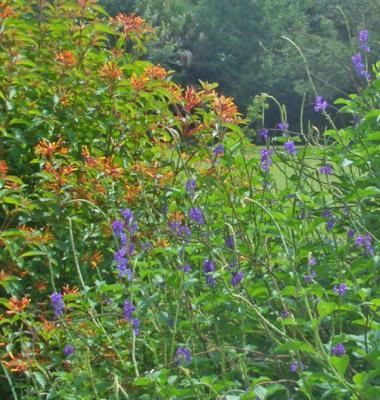 Historic Spanish Point is not only the premier historic site museum in Sarasota County, it is also an environmental museum. The location on the shores of Little Sarasota Bay offers the unique opportunity to view different habitats as well as plant and tree combinations. Native plants representing over 50% of the species found in the county can be enjoyed along the nature trails and boardwalks, including a pristine mangrove shoreline. The Butterfly Garden, one of the largest in Florida, attracts not only avid photographers but many species of insects and birds. In fact, we get so many birds on the site we participate in bird counts for the county in the winter season.
Historic Spanish Point is not only the premier historic site museum in Sarasota County, it is also an environmental museum. The location on the shores of Little Sarasota Bay offers the unique opportunity to view different habitats as well as plant and tree combinations. Native plants representing over 50% of the species found in the county can be enjoyed along the nature trails and boardwalks, including a pristine mangrove shoreline. The Butterfly Garden, one of the largest in Florida, attracts not only avid photographers but many species of insects and birds. In fact, we get so many birds on the site we participate in bird counts for the county in the winter season.
The outdoor museum actively preserves 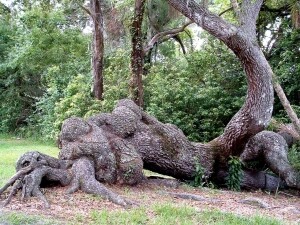 and interprets the Florida native
and interprets the Florida native
environment. The natural ecosystems experienced include; pine flat woods, oak hammocks, tropical hammocks, mangrove swamps, tidal marshes, and coastal beaches. Some of this variety can be attributed to the changes in elevation created by the prehistoric shell middens.
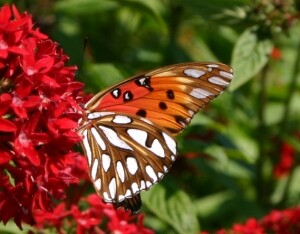 Prehistoric people relied on plants to supplement their seafood diet. Plants were also highly important for many other uses like fuel, fiber, building materials, soaps, dyes, medicines and for use in religious ceremonies. Fruits and starches could be gathered along with acorns and nuts. Leafy plants like pickerel weed were often harvested from wetlands for use as food and dye. Wood items are rarely found intact at archaeological sites like Historic Spanish Point, but we can assume that prehistoric people used available wood for bowls, paddles, building materials, canoes, cooking utensils, tool and weapon handles, and religious symbols. It can also be assumed that due to the importance of plants and trees, they had a name and use for all in their surroundings.
Prehistoric people relied on plants to supplement their seafood diet. Plants were also highly important for many other uses like fuel, fiber, building materials, soaps, dyes, medicines and for use in religious ceremonies. Fruits and starches could be gathered along with acorns and nuts. Leafy plants like pickerel weed were often harvested from wetlands for use as food and dye. Wood items are rarely found intact at archaeological sites like Historic Spanish Point, but we can assume that prehistoric people used available wood for bowls, paddles, building materials, canoes, cooking utensils, tool and weapon handles, and religious symbols. It can also be assumed that due to the importance of plants and trees, they had a name and use for all in their surroundings.
Examples of over 50% of the tree species native to the region can be found on the property. Chief among them is the ecologically important mangrove which grows along the shoreline in an unspoiled habitat. All three species of mangrove are represented. As well as other important coastal trees and plants. Take the walk across Cock’s Footbridge which not only affords terrific views of the bay but the opportunity to see all of the types and environments of the coastal hammock. Recently, a wetlands reclamation project was completed with the removal of invasive non-native vegetation and the addition of a proper wetland ecosystem.
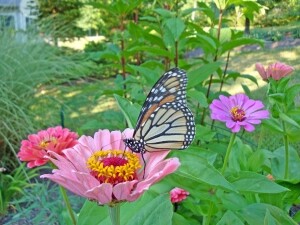 The creation in 2004 of a beautiful Butterfly Garden added a contemporary garden to the historic site. It has grown and expanded in the last four years to be one of the largest and most beautiful on the gulf coast of Florida. Garden clubs and master gardeners, as well as bird watchers and butterfly enthusiasts, journey to Historic Spanish Point each month to explore the colorful garden. Seasonal seminars and tours by volunteer horticulturists will help you to attract butterflies add color to your landscape and learn about the native plants or our region.
The creation in 2004 of a beautiful Butterfly Garden added a contemporary garden to the historic site. It has grown and expanded in the last four years to be one of the largest and most beautiful on the gulf coast of Florida. Garden clubs and master gardeners, as well as bird watchers and butterfly enthusiasts, journey to Historic Spanish Point each month to explore the colorful garden. Seasonal seminars and tours by volunteer horticulturists will help you to attract butterflies add color to your landscape and learn about the native plants or our region.
